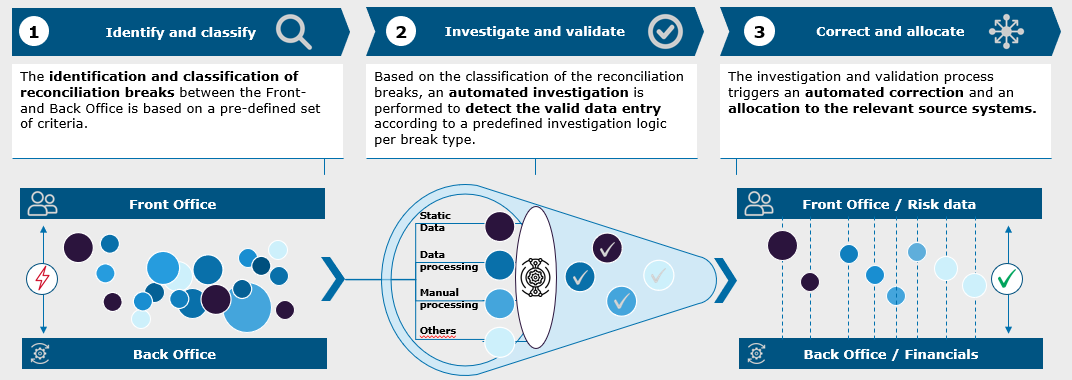Front-to-Back Reconciliation: More efficient reconciliation of your financial data and minimizing manual intervention?
Blog: Capgemini CTO Blog
Financial institutions currently face a challenging environment. They are driven by regulatory requirements and their IT landscapes are becoming more and more outdated. Particularly with recurring and manual processes, a significant increase in efficiency in order to counteract the increasing cost pressure is a must. One such recurring process is the clearing of data breaks in daily reconciliation processes as well as in monthly, quarterly, and annual financial closing procedures. Daily controlling and accounting (Fast & Smart Close) are increasingly required in order to react quickly to changing situations and meet regulatory requirements. In order to achieve these high requirements, automated reconciliation is a vital component. But why is the reconciliation process complex and time-consuming and how can these challenges be overcome?
Challenges in three main areas make reconciliations immensely difficult
The biggest challenges financial institutions face in carrying out their front-to-back (FOBO) reconciliations fall into three crucial categories.
Outdated legacy systems with only a limited number of functional and technical possibilities are responsible for the lack of performance when dealing with a multitude of complex data. In addition, outdated data standards are an increasingly limiting factor in an architectural landscape. Lack of performance, functional limitations, and obsolete data standards greatly reduce the possibility of using modern technologies based on artificial intelligence.
In addition, a complex and highly fragmented IT infrastructure poses challenges to the execution of reconciliations. A large number of systems, a different basis for calculations and processing, as well as a lack of standardization add up to very restrictive circumstances. This leads, for example, to a lack of traceability of the data source from which an error results.
Finally, a focus on data quality must be emphasized. The decisive factor is a lack of central data storage. Furthermore, the data quality is low due to the multi-system landscape causing data breaks between systems, one example could be sourcing of market data from different providers. Ultimately, the data lacks sufficient information content to make derivations for a successful reconciliation.
The three challenges described above lead to:
- Many discrepancies between the front and back office
- Time-consuming, manual, and inefficient investigations and break corrections
- Higher operating risks, e.g. in the event of a breach of regulatory requirements
- Slow and delayed monthly, quarterly, and annual financial statements.
Only with a holistic approach supported by suitable digital tools can the reconciliation process be efficiently aligned

Front-to-back reconciliation requires a holistic approach. This approach can be divided into three stages:
-
Identify and classify
First, the breaks between front and back office must be identified using FOBO Reconciliation Tools. The classification of the breaks is based on predefined criteria. Three main types of data breaks can be identified, to which a large part of the manual analyses and clarification efforts can be assigned:
- Static data breaks: Different source systems to the front and back office lead to breaks between the systems within the scope of data reconciliation and must be corrected manually.
- Data processing breaks: After systemic processing of data, it must be ensured that the data is mapped in the correct format and quality level to facilitate uniform data communication between systems.
- Manually driven data breaks: Enhancement of system data through manual entries and workarounds outside the automated data flow.
-
Investigate and validate
An automated investigation is then carried out using the previously classified data breaks. The purpose of this step is to determine the valid data entries according to a defined validation logic per break type. An example of a check would be the break in accrued interest, driven by different master data sources (e.g., Bloomberg, Reuters, WM), since data sources in the front office have a dynamic character, whereby data sources in the back office are of a static nature.
-
Correct and allocate
Finally, the verification and validation process trigger an automated correction and allocation to the relevant source systems. This enables corrections to be made and any data to be corrected without or limited manual validation. 15. This process can be scaled up due the negative proportionality between the number of entries to be corrected and the necessary manual effort.
Stay tuned for more information on how to detect and eliminate front-to-back breaks in financial closing procedures by Capgemini Invent.
Leave a Comment
You must be logged in to post a comment.








